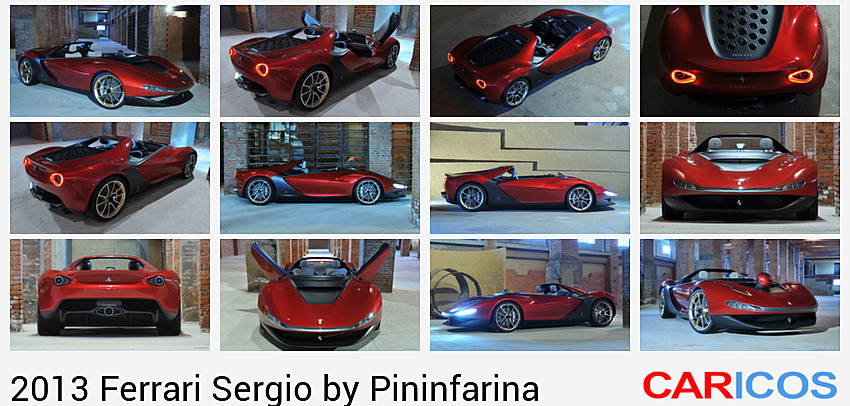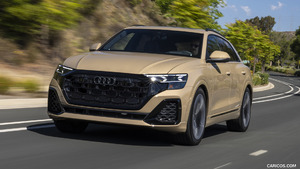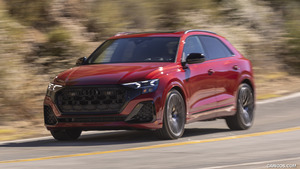Ferrari Sergio by Pininfarina
Pininfarina is presenting a concept car that renews the spirit and values of the extraordinary achievements obtained under the leadership of Sergio Pininfarina, projecting them into the future in the name of exclusivity, innovation and passion. A concept car in line with the approach that has allowed Pininfarina to generate a wealth of creations that have become car legends: the ability to combine passion, creativity, intelligence, technology and elegance in the continuity of the brand's genetic code. A mixture of aesthetic balance and elegant simplicity that last over time and make all Pininfarina models long-lived and resistant to changes in taste and fashion.
The new Pininfarina concept car could only be called Sergio. It is an exercise that Pininfarina decided to undertake on a brand that more than any other has marked the history of Pininfarina: Ferrari. The name of Sergio Pininfarina is inextricably linked to that union conceived 60 years ago: the Sergio, therefore, will also celebrate the importance of Pininfarina's contribution to the history of Prancing Horse design. A tribute that was immediately morally supported by Luca Montezemolo and Ferrari as a whole.
The two-seater barchetta of the future
With the Sergio you enter the fascinating and exciting realm of the two-seater barchetta as a unique and extreme object. Sportsmanship in the truest sense of the joy of driving, the passion of those who view cars as an unequalled source of excitement, the pleasure of admiring the essentiality of a one-off car by Pininfarina. The sports car theme is built into Pininfarina: the fruitful collaboration with Ferrari which began in 1952, has generated some of the most popular sports cars of the postwar period. Returning to the charm of the two- seater Ferrari, compact and very sporty, is moreover, the perfect base for bonding Pininfarina's past to the future. The Sergio's mechanicals are those of the 458 Spider, which remains unchanged in its wheelbase and tracks. The formal interpretation, from which the dynamic, fluid and pure volumes spring, is absolutely free, in the best tradition of that Pininfarina design vision that has produced so many Ferrari-based concept cars recognised over time as masterpieces, such as the Mythos of 1989 and the Rossa of 2000. This approach also reminds us of Pininfarina’s Ferrari-based custom-built cars such as the Testarossa Spider made for Giovanni Agnelli in 1987 or the Ferrari F360 Modena Barchetta in 2000 for Luca Montezemolo.
The result is a modern, organic view of the mid-rear-engined two-seater barchetta. The willingness to revisit volumes and surface treatments in a subliminal way emerges with the Sergio, which evokes the spirit of Pininfarina's best achievements for Ferrari of the ‘60s and ‘70s. A radical object, unique and essential, which rejects the superfluous and is performance-oriented. A real open air car with an explicit nod to racing cars, in the sense that a cupola is not fitted to protect occupants, for which two helmets are provided.
A realistic indeed quite possible concept
The modern interpretation of a barchetta is a choice consistent with one of the historical peculiarities of Pininfarina: mastery in the crafting of exceptional car bodies, capable of stirring emotions and becoming a future icon. The historical role of car body designers directed the design team towards research not on a new, hypothetical product for volume production, but on the creation of an exceptional object capable of expressing the Pininfarina DNA imprint; its exclusivity and development on the basis of a production car, in fact, places the Sergio firmly in the tradition of the great Pininfarina one-offs specifically designed for "special" clients, which makes it a real car, not just a show car.
The design theme
The Sergio is distinguished by a very simple and clear style, that becomes memorable the moment you look at it. Proportions pushed to the extreme, a dynamic front volume penetrating into a rear that is projected forward, a sculpted, three-dimensional interpretation of the typical barchetta. The composition of the two body masses through a longitudinal black insert becomes the design's guideline. Two volumes that enfold from outside to inside the car, creating a division/union line between back and front. Through the extremely fluid passage from one body to another, a form that was homogeneous in its accentuated muscularity was obtained.
The Sergio also expresses an iconicity linked to ‘60s Ferraris proposing bulging and sensual wings inspired by those of sports cars and racing cars of that era, achieved by compacting all volume accessories as much as possible. The extreme lightness of the Sergio, which appears to float with the front up, is a direct result of aerodynamic research. In the purest Pininfarina tradition, design is not an end in itself, but integrates functionality and aesthetics. The front semi-floating development with the spoiler under the front, expresses aesthetic force and is at the same time functional for the stabilisation of the aerodynamic load and the heat exchange. The aerodynamic deflector in front of the cockpit also creates a virtual windscreen through the deviation of the air flow, protecting the passengers from turbulence. The roll bar, designed as a wing surface, is perfectly tuned to the evolution of the flow coming from the front, adding a further down force effect. Finally, the rear nolder and the extractor close the design effectively and functionally. Still on the subject of aerodynamics, even the rear-view mirror takes on a fluid form that, given the flow of the front baffle, helps to divert air from the heads of the passengers.
To enhance the formal purity of the Pininfarina style criterion, all the technical parts of the Sergio (handles, fins, air intake holes) are concentrated in dark parts of the body, leaving the red painted parts free.
The side
The formal harmony of the side view is a strong feature of the Sergio, renewing the common aesthetic denominator of many Ferraris by Pininfarina. In the tradition of barchetta sports cars, the Sergio has no conventional doors but half doors with vertical rotation opening for easy access and contemporarily safeguarding the maximum rigidity of the structure on the side, as in racing cars. The three-quarter front view highlights the theme of the connections between floors and different trends providing a feeling of processed continuity.
The front
On the front, the Sergio takes up and develops the Pininfarina’s traditional integration of the headlights by projecting it into the future in a single transparent transversal element, as in the Dino Berlinetta Speciale 1965. Adapted to the size and technology of our own times, this element becomes an identifying mark, resulting in extremely clean lines. In particular, the cylindrical projectors in aluminium use LED technology and are embedded in a crystalline block of Plexiglas that diffuses light.
The rear
The rear lights reinterpret the circular themes of Pininfarina-Ferrari history transforming them into open functional elements whose forms contemporaneously provide the lighting function and the hot exhaust air coming out of the oil coolers.
The rear bonnet borrows the iconic round graphic holes of other historical Pininfarina achievements and the same treatment is applied to the transom to facilitate cooling of the engine compartment and represents in the best possible way the absolute perfection and timelessness inherent in Pininfarina DNA.
The interior
Since this is a realistic car that could easily be produced in limited series, the Sergio opted for the mechanicals of a completely re-bodied Ferrari 458 spider, maintaining the original technology and its performance. For this reason, the interiors take all the functional parts of existing series (dashboard, seat structure, centre console and steering wheel). The interior is essential and functional and develops as a natural extension of the external surfaces: the black exterior slips into the car and creates the tank where the standard technical components are integrated. Even the engine bonnet descends inside, wrapping round the rear part of seats. The door panels integrate the functions of the handle and armrest and are designed as floating elements separate from the tank.
One innovative element consists of the floating, aerodynamic headrest connected to the roll bar rather than to the body of the seats, almost becoming elements of the exterior than the interior. Besides ensuring maximum purity of the lines, this solution also acts as head fairing in the rear.
In front of the door panel, two helmets are housed in a small recess of the channel. Made to a specific design of Pininfarina Extra in collaboration with Newmax, the Sergio helmets are personalised with the colour of the car body.
Colour and trim
The upholstery is mostly covered with light gray antique-effect leather bound to seats in a weaving technology textile with bronze details. These finishes match the original titanium colour of the standard technical parts. The fabrics on the seats are complemented by the insertion of metal studs that recall the details of the exterior design theme.
The exterior crimson colour, was inspired by the original red of the Dino Berlinetta Speciale, very intense and deep, developing a modern version including metallic particles and a multi-layer depth effect.
The rims represent a contrasting element compared to the rest of the car. The delicate surface of the body is contrasted with technological forms based on the quest for light weight and performance. The gilded finish is an obvious reference to the racing berlinettas of the Sixties and Seventies, even if the treatment is up to date and the surfaces of the spokes are in hand-brushed aluminium.
Aerodynamic studies for a comfortable lightweight sports car
Changes in the body with which the Pininfarina Style Centre has transformed the original car. A Ferrari 458 Spider, into a barchetta were supported by calculations and tests in the Grugliasco wind tunnel to optimise aerodynamic performance. In particular, a totally new body was produced, full carbon, saving about 10% in weight compared to the original body in aluminium, all to the benefit of acceleration and pick-up. Compared to the original car, 21” light alloy one-stud wheels were included, with a specific design, and a hub version derived from the 458 Challenge; new Led taillights, new specific headlamps inserted into the bumper; specific small doors, window-less and opening upward by 45 degrees; new dash top; modified seats, with new fixed head restraints, disconnected from the seat. The roof, windscreen and rear bench seat were removed.
The aerodynamics have made it possible to achieve interesting results, starting with the creation of a virtual windscreen. The elimination of the windscreen would, in fact, involve a flow of air at increasing pressure as the car’s speed increases on the heads of the driver and passenger. The engineers and designers at Pininfarina have therefore designed, built and tested an airfoil placed in a recess on the front bonnet, which produces a double deflection of the air flow entering the passenger compartment. The first deviation is from the wing itself, the second from the air that accelerates in the channel created between the airfoil and the corresponding shape of the recess in the trunk. The result is that, thanks to the virtual windscreen, the air passes above the heads of the driver and the passenger, greatly increasing comfort. This aerodynamic effect also contributes to increase the down force on the car's front axle. The virtual windscreen is effective at speeds as low as 50 kph.
The loss of aerodynamic load on the front axle, due to the elimination of the windscreen, has been recovered from a wing inserted in the front bumper. The shape and dimensions of the wing are calculated so as to give the required load at the various speeds and, at the same time, allow correct flow of air to the radiators of the cooling system, set centrally at the front.
To improve the protection of the occupants a roll-bar with a fixed spoiler increases the down force on the rear axle. The attention to detail goes so far as the central rear-view mirror, whose form has been aerodynamically optimised to link up with the air flow of the virtual windscreen. The engine's air intake is channelled from the air inlets in the two sides. The air vents at the base of the roll-bar convey the cooling air to the oil coolers.
Overall, the Sergio offers real sports performance, with a shell of torsion stiffness which exceeds that of the original spider, thanks to the reduction in the size of the doors, and the reduction of the total mass of about 150 kg compared to the spider. This allows good handling and a further improvement of acceleration, estimated at below 3.4 seconds for 0-100 kph, at the top of its class.
TECHNICAL SPECIFICATIONS
- Maximum length: 4550 mm
- Maximum width: 1940 mm
- Maximum height: 1140 mm
- Boot capacity: 110 litres
- Power train (original Ferrari 458 Spider): 4499cc V8; Sequential gearbox 7M + RM
- Package: 2 doors, 2 seats
- Chassis: original 458 Spider
- Cx XS: about 5% lower than the original car
- Weight: about 1280 kg
- Maximum speed: approx 320 km/h
- Acceleration from 0 to 100: less than 3.4 seconds














